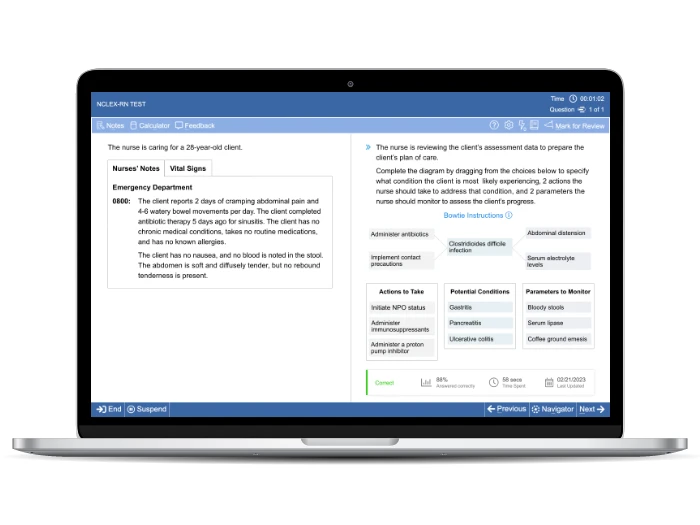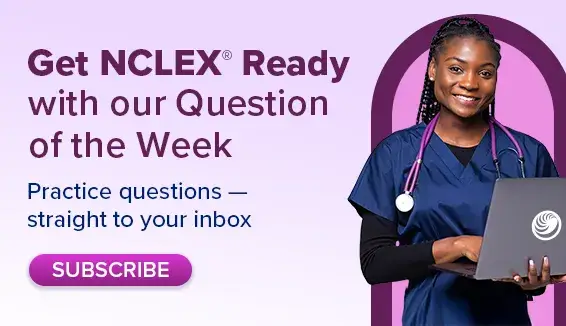You’ve probably heard rumors that real NCLEX questions are vague or ambiguous. Let’s set the record straight: that’s not the case! NCLEX® questions may seem vague or difficult to answer at face value, but this perception often comes from a misunderstanding of the exam itself.
On the NCLEX…
Both your knowledge and clinical judgment are being examined.
So while a NCLEX question may be seemingly vague, and may not appear to offer a lot of context, a deeper analysis usually reveals what’s really being asked. Below, our exam experts will walk you through how to decipher what exactly is being asked to improve your likelihood of passing.
How Vague Are NCLEX Questions?
Many NCLEX questions are one line: Here’s a situation, answer the question. This can make it difficult to infer what specific skill is being assessed and what the correct answer is.
It’s important to remember that:
The NCLEX is prepared by nursing educators and subject-matter experts to evaluate a candidate’s ability to apply critical thinking skills and make effective nursing judgments.
In real-life practice, you will regularly find yourself confronted with situations that require you to make sound judgments based on limited information. Put another way, you will not always receive a lot of clues as to how to approach a problem. The NCLEX does a good job of simulating this experience, making concise (not necessarily vague) questions more realistic.
Approaching Vague NCLEX Questions
The trick to correctly answering vague NCLEX questions is to understand the question within the question. Confused? Don’t be. All we mean is to learn to analyze the question stem and exhibit to reveal the main point of a question. Once you master this, you’ll be able to approach any NCLEX question successfully.
Understanding the Question Stem
Identifying the “stem” of a question refers to recognizing the main body of the question that presents the clinical scenario, patient information, and context of the situation. The stem contains all the relevant information needed to understand the scenario and formulate an appropriate nursing response.

Defining the Question Stem
Clinical scenario refers to a real-life situation or scenario that requires nursing intervention or decision-making. It might describe a patient’s problem, specific nursing task, or decision that needs to be made.
Patient information includes details about the patient’s medical condition, symptoms, background, and any relevant history. Understanding the patient’s situation is crucial for answering the question accurately.
Context describes how you need to apply your nursing knowledge and critical thinking skills. This context is essential for determining the scope of the question and choosing the appropriate nursing action.
Question prompt describes when the stem concludes and asks you to identify the best nursing intervention, action, or response based on the presented scenario. Look for keywords in the question that can give you clues about what the question is asking, such as “first,” “priority,” or “increased/decreased.” Understanding what the question asks you to do can help you approach it more effectively.
Looking for Clues in the Exhibit

NCLEX exhibits refer to additional information that’s presented alongside the question stem. Several examples of what can be found in an exhibit include:
- Laboratory results
- Diagnostic images
- Medical records
- Medication orders
Nursing students should pay close attention to exhibits for two primary reasons…
- Exhibits are realistic representations of the kind of information nurses encounter in real-world clinical settings. This mirrors the practical situations that nurses face, where they must interpret and respond to various data types.
- Exhibits provide context to the scenario. Understanding the context of a situation is vital for making informed decisions and selecting appropriate nursing interventions.
Evaluating NCLEX Answer Choices
Once you learn how to analyze NCLEX question stems and exhibits, the final step to deciphering the meaning behind a question and arriving at the “most correct” solution is to evaluate the available answer choices.
- Read Each Choice Carefully: Start by reading each answer choice thoroughly. Pay attention to the wording, as even subtle differences can change the meaning and relevance of the option.
- Eliminate Obvious Incorrect Choices: If there are any answer choices that are clearly incorrect or unrelated to the scenario, eliminate them immediately. This can help narrow down your options and focus your attention on the more plausible choices.
- Consider Patient Safety: Prioritize answer choices that ensure the safety and well-being of the patient. If a choice involves any potential harm to the patient, it is likely not the correct option.
- Apply ABCs or Maslow’s Hierarchy: Depending on the scenario, consider using the ABCs (Airway, Breathing, Circulation) approach for critical situations, or apply Maslow’s Hierarchy of Needs to address the patient’s physiological and psychosocial needs.
- Refer to Nursing Priorities: Reflect on the nursing priorities for the given scenario. Which interventions should be addressed first based on the patient’s condition and immediate needs?
- Consider Timing: Some answer choices may be appropriate, but not the most timely interventions. Choose the option that best aligns with the current phase of the patient’s care.
- Look for Evidence-Based Practice: Choose answers that align with evidence-based practice and established nursing protocols. These choices are more likely to reflect safe and effective care.
- Consider Cultural Sensitivity: Take cultural, ethical, and diversity considerations into account when evaluating answer choices. Ensure that your choice respects the patient’s values and preferences.
- Choose the Best Fit: Ultimately, choose the answer choice that best fits the scenario, aligns with your nursing knowledge, and addresses the patient’s needs in a safe and appropriate manner.
Enhancing Critical Thinking Strategies
To reiterate, concise and “thin” NCLEX questions are not necessarily vague. They’re likely written in a way designed to challenge your critical thinking abilities and clinical judgment. If you come across a particularly difficult question, take a step back and search for the intended meaning. Evaluating limited information and arriving at reasoned decisions is what will be required of you during real-life practice. By developing these skills now, you’ll put yourself in a better position to pass the NCLEX and excel in your career.







